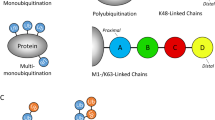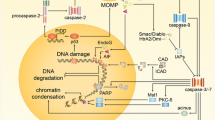Abstract
DEK protein is an ubiquitous phosphorylated nuclear protein. Specific binding of DEK to DNA could change the topology of DNA and then affect the gene activity of the underlying DNA sequences. It is speculated that there might be some potential relationship between the stress reaction of cells and DEK proteins. The phosphorylation status of DEK protein is altered during death-receptor-mediated cell apoptosis. Both phosphorylation and poly(ADP-ribosyl)ation could promote the release of DEK from apoptotic nuclei to extracellular environment, and in this case DEK becomes a potential autoantigen of some autoimmune diseases. The available evidence powerfully suggests that DEK protein is closely relevant to apoptosis. The overexpression of DEK protein has dual function in cell apoptosis, in terms of inhibiting or triggering cell apoptosis.
Similar content being viewed by others
References
Waldmann T, Scholten I, Kappes F, et al. The DEK protein-an abundant and ubiquitous constituent of mammalian chromatin. Gene, 2004, 343: 1–9, 15563827, 10.1016/j.gene.2004.08.029, 1:CAS:528:DC%2BD2cXhtVahsr7K
Wichmann I, Respaldiza N, Garcia-Lozano J R, et al. Autoantibodies to DEK oncoprotein in systemic lupus erythematosus (SLE). Clin Exp Immunol, 2000, 119: 530–532, 10691927, 10.1046/j.1365-2249.2000.01154.x, 1:STN:280:DC%2BD3c7ls1Wquw%3D%3D
Dong X, Wang J, Kabir F N, et al. Autoantibodies to DEK oncoprotein in human inflammatory disease. Arthritis Rheum, 2000, 43: 85–93, 10643703, 10.1002/1529-0131(200001)43:1<85::AID-ANR11>3.0.CO;2-D, 1:CAS:528:DC%2BD3cXns1yhug%3D%3D
Dong X, Michelis M A, Wang J, et al. Autoantibodies to DEK oncoprotein in a patient with systemic lupus erythematosus and sarcoidosis. Arthritis Rheum, 1998, 41: 1505–1510, 9704652, 10.1002/1529-0131(199808)41:8<1505::AID-ART23>3.0.CO;2-N, 1:STN:280:DyaK1czmvVemsg%3D%3D
Murray K J, Szer W, Grom A A, et al. Antibodies to the 45 kDa DEK nuclear antigen in pauciarticular onset juvenile rheumatoid arthritis and iridocyclitis: Selective association with MHC gene. J Rheumatol, 1997, 24: 560–567, 9058666, 1:STN:280:DyaK2s3htFKquw%3D%3D
Sierakowska H, Williams K R, Szer I S, et al. The putative oncoprotein DEK, part of a chimera protein associated with acute myeloid leukaemia, is an autoantigen in juvenile rheumatoid arthritis. Clin Exp Immunol, 1993, 94: 435–439, 8252804, 1:CAS:528:DyaK2cXlt1WqsQ%3D%3D, 10.1111/j.1365-2249.1993.tb08214.x
Von Lindern M, Fornerod M, van Baal S, et al. The translocation (6;9), associated with a specific subtype of acute myeloid leukemia, results in the fusion of two genes, dek and can, and the expression of a chimeric, leukemia-specific dek-can mRNA. Mol Cell Biol, 1992, 12: 1687–1697
Ageberg M, Drott K, Olofsson T, et al. Identification of a novel and myeloid specific role of the leukemia-associated fusion protein DEK-NUP214 leading to increased protein synthesis. Genes Chromosomes Cancer, 2008, 47: 276–287, 18181180, 10.1002/gcc.20531, 1:CAS:528:DC%2BD1cXivFers7g%3D
Wise-Draper T M, Mintz-Cole R A, Morris T A, et al. Overexpression of the cellular DEK protein promotes epithelial transformation in vitro and in vivo. Cancer Res, 2009, 69: 1792–1799, 19223548, 10.1158/0008-5472.CAN-08-2304, 1:CAS:528:DC%2BD1MXisFSrt74%3D
Wu Q, Li Z, Lin H, et al. DEK overexpression in uterine cervical cancers. Pathol Int, 2008, 58: 378–382, 18477217, 10.1111/j.1440-1827.2008.02239.x, 1:CAS:528:DC%2BD1cXosVWhs78%3D
Orlic M, Spencer C E, Wang L, et al. Expression analysis of 6p22 genomic gain in retinoblastoma. Genes Chromosomes Cancer, 2006, 45: 72–82, 16180235, 10.1002/gcc.20263, 1:CAS:528:DC%2BD2MXht1Kgu7zO
Carro M S, Spiga F M, Quarto M, et al. DEK Expression is controlled by E2F and deregulated in diverse tumor types. Cell Cycle, 2006, 5: 1202–1207, 16721057, 1:CAS:528:DC%2BD28XnvFWqtLc%3D
Sanchez-Carbayo M, Socci N D, Lozano J J, et al. Gene discovery in bladder cancer progression using cDNA microarrays. Am J Pathol, 2003, 163: 505–516, 12875971, 1:CAS:528:DC%2BD3sXmslSnsL8%3D
Larramendy M L, Niini T, Elonen E, et al. Overexpression of translocation-associated fusion genes of FGFRI, MYC, NPMI, and DEK, but absence of the translocations in acute myeloid leukemia. A microarray analysis. Haematologica, 2002, 87: 569–577, 12031912, 1:CAS:528:DC%2BD38XlsFCit7o%3D
Kroes R A, Jastrow A, McLone M G, et al. The identification of novel therapeutic targets for the treatment of malignant brain tumors. Cancer Lett, 2000, 156: 191–198, 10880769, 10.1016/S0304-3835(00)00462-6, 1:CAS:528:DC%2BD3cXksFGis7g%3D
Grottke C, Mantwill K, Dietel M, et al. Identification of differentially expressed genes in human melanoma cells with acquired resistance to various antineoplastic drugs. Int J Cancer, 2000, Nov 15; 88: 535–546, 11058868, 10.1002/1097-0215(20001115)88:4<535::AID-IJC4>3.0.CO;2-V, 1:STN:280:DC%2BD3crhtFemuw%3D%3D
Kondoh N, Wakatsuki T, Ryo A, et al. Identification and characterization of genes associated with human hepatocellular carcinogenesis. Cancer Res, 1999, 59: 4990–4996, 10519413, 1:CAS:528:DyaK1MXmslWktbk%3D
Wise-Draper T M, Allen H V, Jones E E, et al. Apoptosis inhibition by the human DEK oncoprotein involves interference with p53 functions. Mol Cell Biol, 2006, 26: 7506–7519, 16894028, 10.1128/MCB.00430-06, 1:CAS:528:DC%2BD28XhtFCgur3I
Wise-Draper T M, Morreale R J, Morris T A, et al. DEK proto-oncogene expression interferes with the normal epithelial differentiation program. Am J Pathol, 2009, 174: 71–81, 19036808, 10.2353/ajpath.2009.080330, 1:CAS:528:DC%2BD1MXhslOlu7w%3D
Kappes F, Burger K, Baack M, et al. Subcellular localization of the human proto-oncogene protein DEK. J Biol Chem, 2001, 276: 26317–26323, 11333257, 10.1074/jbc.M100162200, 1:CAS:528:DC%2BD3MXlsVKnsbk%3D
Hu H G, Scholten I, Gruss C, et al. The distribution of the DEK protein in mammalian chromatin. Biochem Biophys Res Commun, 2007, 358: 1008–1014, 17524367, 10.1016/j.bbrc.2007.05.019, 1:CAS:528:DC%2BD2sXmtFKqtbk%3D
Kappes F, Fahrer J, Khodadoust M S, et al. DEK is a poly(ADP-ribose)-acceptor in apoptosis and mediates resistance to genotoxic stress. Mol Cell Biol, 2008, 28: 3245–3257, 18332104, 10.1128/MCB.01921-07, 1:CAS:528:DC%2BD1cXlvFeru7Y%3D
Scholten I. Characterisation of the proto-oncoprotein DEK. doctoral thesis University of Konstanz, 2004
Kappes F, Damoc C, Knippers R, et al. Phosphorylation by protein kinase CK2 changes the DNA binding properties of the human chromatin protein DEK. Mol Cell Biol, 2004, 24: 6011–6020, 15199154, 10.1128/MCB.24.13.6011-6020.2004, 1:CAS:528:DC%2BD2cXls1aqtLo%3D
Kipp M, Gohring F, Ostendorp T, et al. SAF-Box, a conserved protein domain that specifically recognizes scaffold attachment region DNA. Mol Cell Biol, 2000, 20: 7480–7489, 11003645, 10.1128/MCB.20.20.7480-7489.2000, 1:CAS:528:DC%2BD3cXnt1aitr0%3D
Aravind L, Koonin E V. SAP-a putative DNA-binding motif involved in chromosomal organization. Trends Biochem Sci, 2000, 25: 112–114, 10694879, 10.1016/S0968-0004(99)01537-6, 1:CAS:528:DC%2BD3cXhsFOisrs%3D
Kappes F, Scholten I, Richter N, et al. Functional domains of the ubiquitous chromatin protein DEK. Mol Cell Biol, 2004, 24: 6000–6010, 15199153, 10.1128/MCB.24.13.6000-6010.2004, 1:CAS:528:DC%2BD2cXls1aqtL0%3D
Devany M, Kappes F, Chen K M, et al. Solution NMR structure of the N-terminal domain of the human DEK protein. Protein Sci, 2008, 17: 205–215, 18227428, 10.1110/ps.073244108, 1:CAS:528:DC%2BD1cXhvVOntL8%3D
Waldmann T, Baack M, Richter N, et al. Structure-specific binding of the proto-oncogene protein DEK to DNA. Nucleic Acids Res, 2003, 31: 7003–7010, 14627833, 10.1093/nar/gkg864, 1:CAS:528:DC%2BD3sXptlyktL4%3D
Waldmann T, Eckerich C, Baack M, et al. The ubiquitous chromatin protein DEK alters the structure of DNA by introducing positive su-percoils. J Biol Chem, 2002, 277: 24988–24994, 11997399, 10.1074/jbc.M204045200, 1:CAS:528:DC%2BD38XlsVWitL4%3D
Alexiadis V, Waldmann T, Andersen J, et al. The protein encoded by the proto-oncogene DEK changes the topology of chromatin and reduces the efficiency of DNA replication in a chromatin-specific manner. Genes Dev, 2000, 14: 1308–1312, 10837023, 1:CAS:528:DC%2BD3cXjvFOgsbw%3D
Soares L M, Zanier K, Mackereth C, et al. Intron removal requires proofreading of U2AF/3′splice site recognition by DEK. Science, 2006, 312: 1961–1965, 16809543, 10.1126/science.1128659, 1:CAS:528:DC%2BD28XmsVahu7k%3D
Sammons M, Wan S S, Vogel N L, et al. Negative regulation of the RelA/p65 transactivation function by the product of the DEK proto-oncogene. J Biol Chem, 2006, 281: 26802–26812, 16829531, 10.1074/jbc.M600915200, 1:CAS:528:DC%2BD28XptlKnu7Y%3D
Hollenbach A D, McPherson C J, Mientjes E J, et al. Daxx and histone deacetylase II associate with chromatin through an interaction with core histones and the chromatin-associated protein Dek. J Cell Sci, 2002, 115: 3319–3330, 12140263, 1:CAS:528:DC%2BD38XmvVeqt7s%3D
Faulkner N E, Hilfinger J M, Markovitz D M. Protein phosphatase 2A activates the HIV-2 promoter through enhancer elements that include the pets site. J Biol Chem, 2001, 276: 25804–25812, 11320078, 10.1074/jbc.M006454200, 1:CAS:528:DC%2BD3MXlsVKgtb8%3D
Wise-Draper T M, Allen H V, Thobe M N, et al. The human DEK proto-oncogene is a senescence inhibitor and an upregulated target of high-risk human papillomavirus E7. J Virol, 2005, 79: 14309–14317, 16254365, 10.1128/JVI.79.22.14309-14317.2005, 1:CAS:528:DC%2BD2MXht1ShsLnP
Cleary J, Sitwala K V, Khodadoust M S, et al. p300/CBP-associated factor drives DEK into interchromatin granule clusters. J Biol Chem, 2005, 280: 31760–31767, 15987677, 10.1074/jbc.M500884200, 1:CAS:528:DC%2BD2MXpslejsLw%3D
Sarno S, Reddy H, Meggio F, et al. Selectivity of 4,5,6,7-tetrabro-mobenzotriazole, an ATP site-directed inhibitor of protein kinase CK2 (’casein kinase-2’). FEBS Lett, 2001, 496: 44–48, 11343704, 10.1016/S0014-5793(01)02404-8, 1:CAS:528:DC%2BD3MXjtlCit7o%3D
Tabbert A, Kappes F, Knippers R, et al. Hypophosphorylation of the architectural chromatin protein DEK in death-receptor-induced apoptosis revealed by the isotope coded protein label proteomic platform. Proteomics, 2006, 6: 5758–5772, 17001602, 10.1002/pmic.200600197, 1:CAS:528:DC%2BD28Xht1yqsbnJ
Gamble M J, Fisher R P. SET and PARP1 remove DEK from chromatin to permit access by the transcription machinery. Nat Struct Mol Biol, 2007, 14: 548–555, 17529993, 10.1038/nsmb1248, 1:CAS:528:DC%2BD2sXmtVyjtb8%3D
Mor-Vaknin N, Punturieri A, Sitwala K, et al. The DEK nuclear autoantigen is a secreted chemotactic factor. Mol Cell Biol, 2006, 26: 9484–9496, 17030615, 10.1128/MCB.01030-06, 1:CAS:528:DC%2BD28XhtlemsLnK
Strahl B D, Allis C D. The language of covalent histone modifications. Nature, 2000, 403: 41–45, 10638745, 10.1038/47412, 1:STN:280:DC%2BD3c7gt1arsQ%3D%3D
Zhang Y, Ng H H, Erdjument-Bromage H, et al. Analysis of the NuRD subunits reveals a histone deacetylase core complex and a connection with DNA methylation. Genes Dev, 1999, 13: 1924–1935, 10444591, 10.1101/gad.13.15.1924, 1:CAS:528:DyaK1MXltlGktbg%3D
Grunstein M. Histone acetylation in chromatin structure and transcription. Nature, 1997, 389: 349–352, 9311776, 10.1038/38664, 1:CAS:528:DyaK2sXmsVWntLk%3D
O’Neill L P, Turner B M. Histone H4 acetylation distinguishes coding regions of the human genome from heterochromatin in a differentiation-dependent but transcription-independent manner. Embo J, 1995, 14: 3946–3957, 7664735
Clarke D J, O’Neill L P, Turner B M. Selective use of H4 acetylation sites in the yeast Saccharomyces cerevisiae. Biochem J, 1993, 294 557–561, 8373369, 1:CAS:528:DyaK3sXlvF2htLk%3D
Liu X, W L, Zhao K, et al. The structural basis of protein acetylation by the p300/CBP transcriptional coactivator. Nature, 2008; 451: 846–850, 18273021, 10.1038/nature06546, 1:CAS:528:DC%2BD1cXhvVyms74%3D
Ko S I, Lee I S, Kim J Y, et al. Regulation of histone acetyltransferase activity of p300 and PCAF by proto-oncogene protein DEK. FEBS Lett, 2006, 580: 3217–3222, 16696975, 10.1016/j.febslet.2006.04.081, 1:CAS:528:DC%2BD28XltVKmsrY%3D
Lee K S, Kim D W, Kim J Y, et al., Caspase-dependent apoptosis induction by targeted expression of DEK in drosophila involves histone acetylation inhibition. J Cell Biochem, 2008, 103: 1283–1293, 17685435, 10.1002/jcb.21511, 1:CAS:528:DC%2BD1cXjtVyntbc%3D
Williams T, Admon A, Luscher B, et al. Cloning and expression of AP-2, a cell-type-specific transcription factor that activates inducible enhancer elements. Genes Dev, 1988: 1557–1569
Mitchell P J, Wang C, Tjian R. Positive and negative regulation of transcription in vitro: Enhancer-binding protein AP-2 is inhibited by SV40 T antigen. Cell, 1987, 50: 847–861, 3040262, 10.1016/0092-8674(87)90512-5, 1:CAS:528:DyaL1cXltVCksw%3D%3D
Hilger-Eversheim, K, Moser M, Schorle H, et al. Regulatory roles of AP-2 transcription factors in vertebrate development, apoptosis and cell-cycle control. Gene, 2000, 260: 1–12, 11137286, 10.1016/S0378-1119(00)00454-6, 1:CAS:528:DC%2BD3MXnslSqug%3D%3D
Williams T, Tjian R. Analysis of the DNA-binding and activation properties of the human transcription factor AP-2. Genes Dev, 1991, 5: 670–682, 2010091, 10.1101/gad.5.4.670, 1:CAS:528:DyaK3MXitVChsL0%3D
Campillos, M, Garcia M A, Valdivieso F, et al. Transcriptional activation by AP-2alpha is modulated by the oncogene DEK. Nucleic Acids Res, 2003, 31: 1571–1575, 12595566, 10.1093/nar/gkg247, 1:CAS:528:DC%2BD3sXit1yks74%3D
Mitchell P J, Timmons P M, Hebert J M, et al. Transcription factor AP-2 is expressed in neural crest cell lineages during mouse embryogenesis. Genes Dev, 1991, 5: 105–119, 1989904, 10.1101/gad.5.1.105, 1:CAS:528:DyaK3MXpvV2nsQ%3D%3D
Vogelstein B, Kinzler K W. Cancer genes and the pathways they control. Nat Med, 2004, 10: 789–799, 15286780, 10.1038/nm1087, 1:CAS:528:DC%2BD2cXmtFWrt7o%3D
Vogelstein B, Lane D, Levine A J. Surfing the p53 network. Nature, 2000, 408: 307–310, 11099028, 10.1038/35042675, 1:CAS:528:DC%2BD3cXosVemtrY%3D
Levine A J. p53, the cellular gatekeeper for growth and division. Cell, 1997, 88: 323–331, 9039259, 10.1016/S0092-8674(00)81871-1, 1:CAS:528:DyaK2sXhtFahtLg%3D
Kim D W, Chae J I, Kim J Y, et al. Proteomic analysis of apoptosis related proteins regulated by proto-oncogene protein DEK. J Cell Biochem, 2009, 106: 1048–1059, 19229864, 10.1002/jcb.22083, 1:CAS:528:DC%2BD1MXkslCktLY%3D
Author information
Authors and Affiliations
Corresponding author
Additional information
Contributed equally to this work
Supported by the Science and Technology Foundation of Beijing Jiaotong University (Grant Nos. 2006RC035 and 2007XM047).
Rights and permissions
About this article
Cite this article
Hua, Y., Hu, H. & Peng, X. Progress in studies on the DEK protein and its involvement in cellular apoptosis. SCI CHINA SER C 52, 637–642 (2009). https://doi.org/10.1007/s11427-009-0088-2
Received:
Accepted:
Published:
Issue Date:
DOI: https://doi.org/10.1007/s11427-009-0088-2




